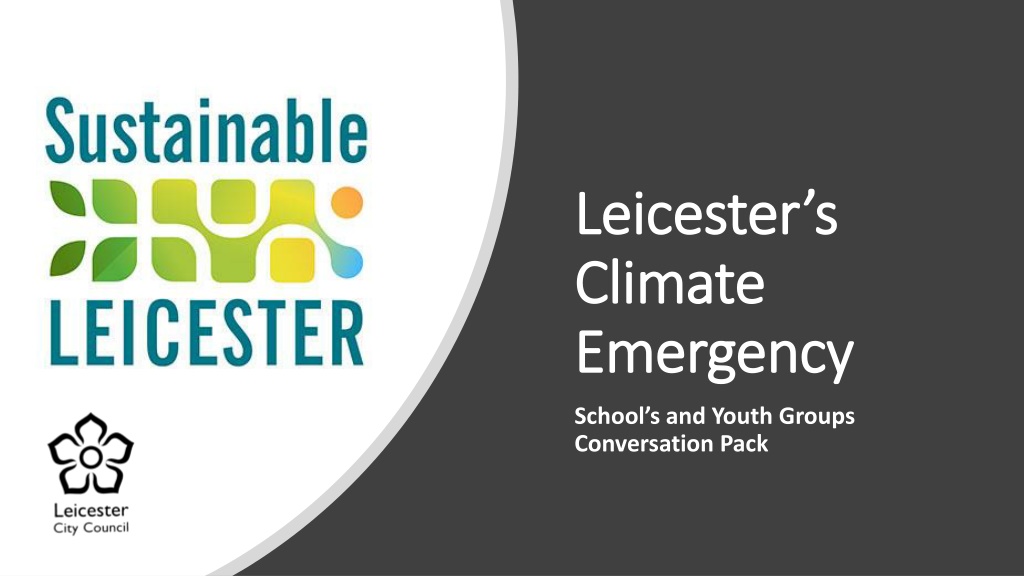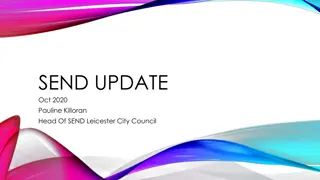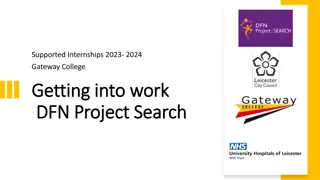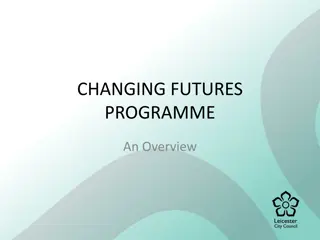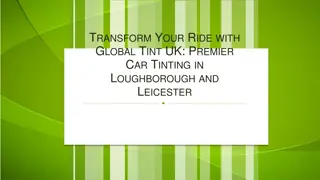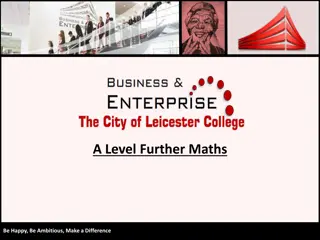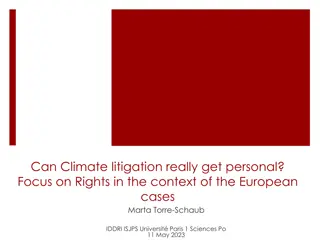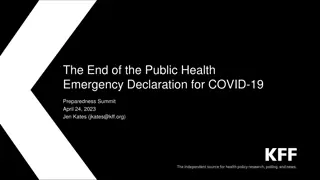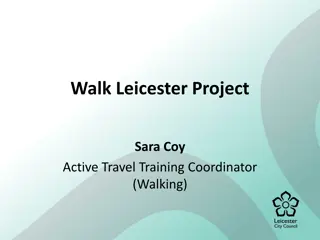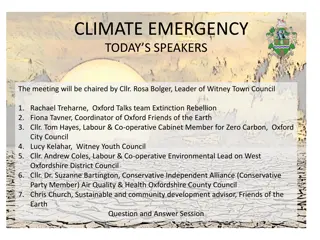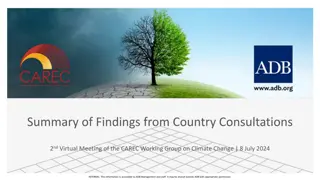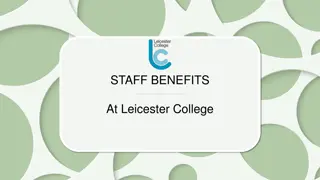Addressing the Climate Emergency in Leicester: Proposals and Actions
In Leicester, there is a push to address the climate emergency through various proposals and actions aimed at reducing carbon emissions, promoting sustainability, and creating a more energy-efficient city. The conversation pack discusses themes such as consumer choices, waste management, land use, and offsetting emissions, highlighting the importance of collective efforts in transitioning towards a greener future for the city.
Download Presentation

Please find below an Image/Link to download the presentation.
The content on the website is provided AS IS for your information and personal use only. It may not be sold, licensed, or shared on other websites without obtaining consent from the author. Download presentation by click this link. If you encounter any issues during the download, it is possible that the publisher has removed the file from their server.
E N D
Presentation Transcript
Leicesters Leicester s Climate Climate Emergency Emergency School s and Youth Groups Conversation Pack
How will life in the city How will life in the city need to change and what need to change and what should we do about it? should we do about it?
At home Travel and transport The proposals The proposals are divided are divided into six into six themes: themes: Our choices as consumers Waste At work Land use, green space and development
Offsetting some emissions that will be very hard to stop completely Reducing our overall carbon emissions to nearly zero What does What does carbon carbon neutral neutral mean? mean? The term carbon neutral can be used for a whole city or a part of it such as a building or an organisation Making more renewable energy than we need and supply it to others For now, we don t think Leicester can reduce it s carbon emissions to zero but we can do our best to get as close to zero as possible
Do you have any comments on the vision for each theme? Which actions ones are most important? Are there any actions that you don t support? If so, why? Discussing our Discussing our proposals proposals Are there any actions that might not be possible? If so, what would need to happen to make them possible? How do you think the actions might positively or negatively affect people in your school? What, if any, support do you think people will need? Are there any other actions you would like to suggest?
At Home At Home Heating of homes and the use of electricity for lighting, appliances and gadgets causes about a third of carbon emissions in Leicester from our direct fuel and energy use. To reduce these emissions, housing will need to be made a lot more energy efficient and heating will need to change. A big increase in renewable energy will be needed too. Many people will need help to make these changes.
Vision for existing homes Vision for existing homes Homes need to be highly insulated to keep warm using much less energy. This will mean that fewer people get health problems from cold homes. Heat pumps that take heat from the ground or air replace gas heating and hot water. Low-carbon heat networks will need to be used in areas with denser housing providing heat and hot water to whole neighbourhoods through underground pipes. The move away from gas will increase electricity demand. Homes will need to have their own renewable energy like solar panels. These will provide power to the house and owners could get money for selling back excess electricity.
Vision for existing homes Vision for existing homes Houses will need smart systems such as remote control for heating and lighting, and batteries to store extra energy from solar panels. They will also need to be able to charge electric cars. Homes will also need to be kept cool without air conditioning, as this uses a lot of energy. This might mean fitting shades and shutters, or planting trees for shade. Water use will need to fall, as low rainfall could become more of a problem.
Travel and transport Travel and transport Travel and transport are a large source of carbon emissions in Leicester. These emissions come from petrol, diesel and LPG vehicles. Leicester s population is expected keep growing, so more people will need to access work and facilities. If changes are not made this will add to Leicester s carbon emissions.
Vision for travel and transport Vision for travel and transport We think that the following things will need to happen: A much greater share of journeys will need to be made by walking, cycling and public transport. A city-wide network of walking and cycling routes, along with improved public transport, will be among the improvements needed to make this possible. Journeys that can t be taken by walking, cycling or public transport will need to be made by ultra-low emission vehicles. These will mainly be electric vehicles, although new HGVs may need to be hydrogen- powered. Electric charging-points will need to be widely available across the city. The electricity grid in Leicester may need upgrading to allow this. More solar panels will help provide some of the electricity needed.
Vision for travel and transport Vision for travel and transport Some electric cars will need to be part of vehicle-to-grid systems. These store surplus renewable electricity from solar panels in electric car batteries. They help the electricity grid by selling it to the grid when demand is high. Alternative travel and transport services, such as ride-sharing, electric car clubs and e-bike share could be used more instead of private car journeys. Services and facilities will need to be easy to access without car journeys. This includes making them accessible online, and available nearby within communities.
Our choices as consumers Our choices as consumers As well as the carbon emissions we produce within the city, we are also responsible for emissions elsewhere produced from making and delivering the products and the services we buy in from outside. They could add at least another 40% to the total. For the city to become carbon neutral we have to do something about them too. We think that the following things will need to change in Leicester to deal with our emissions as consumers:
Vision for consumer choices Vision for consumer choices All of us will need to become well-informed about the climate impacts of what we buy so that we can make climate-friendly choices. Customer demand for climate-friendly products and services will need to convince shops, manufacturers and suppliers to provide them. Customer demand will need to convince manufacturers to produce long-lasting products which can be repaired. Disposable and short- lived products cause extra carbon emissions when they have to be replaced.
Vision for consumer choices Vision for consumer choices The overall consumption of beef, lamb and other meat, eggs and dairy produce will need to be a lot lower than today. There will need to be much more emphasis on plant-based ingredients. Food miles will need to reduce too. Air travel will need to reduce a lot unless zero-carbon flights become possible.
Waste Waste Disposal and treatment of waste uses a lot of energy, which causes carbon emissions. Things that are sent to landfill also produce greenhouse gases when they decay. More emissions come from producing new things to replace what is thrown away. The best way to reduce waste is to follow the Waste Hierarchy . This says that the best thing to do is avoid making waste, and then re-use anything that is made. Things that can t be re-used should be recycled. If there is anything left it is better to recover energy from it, with sending it to landfill the worst option. To reduce the carbon emissions of waste in Leicester we think that the following things will need to happen:
Vision for waste and recycling Vision for waste and recycling Households will need to produce less waste. This will mean not buying things that will be wasted, buying products and services that are produced sustainably and re-using and repairing what they already own. Businesses and organisations will need to produce less waste from what they make and sell and the services they provide. Products and packaging will also need to be easier for consumers to re-use, repair and recycle. As much waste as possible will need to be recycled. The council will need to support homes to do this through the city s waste collection service. Businesses and organisations will need make sure their waste is disposed of responsibly. Food and garden waste will need to be composted.
Vision for waste and recycling Vision for waste and recycling Where waste can t be recycled, it will need to be used for energy instead of landfilled. This includes a small amount of Energy-from- Waste and biogas. The council will need to lead by example, to reduce, re-use and recycle waste. The council will also need to educate residents and businesses and promote its existing waste and recycling services. The UK government will need to support this through their new Resources and Waste strategy. The council will need to produce a new Waste Strategy for the city based on this.
At Work At Work The gas and electricity used by businesses and other employers is one of the largest sources of carbon emissions in the city. Commuting by employees, travel for work, and the transport of goods causes carbon emissions too. The materials bought and used by businesses also have a carbon footprint. To reduce these emissions employers buildings will need to be much more energy efficient and heated differently. They will need to have renewable energy sources fitted. Employers will also need to make sure their products and services are sustainable. This includes using recycled materials and making products easier to reuse and recycle. This section covers businesses and organisations like charities, schools and universities. It also covers public services including the council and NHS.
Vision for employers Vision for employers Businesses and other employers will need to use low or zero carbon heating and cooling systems and generate their own renewable electricity wherever possible. Workplaces will also need to be more highly insulated to reduce their heating need. Business processes and equipment will need to be much more energy and resource efficient. Production processes will need to be carbon neutral using renewable energy generated on-site where possible.
Vision for employers Vision for employers All items and materials procured by businesses and organisations will eventually need to come from sustainable sources, for example using recycled materials. Customers will expect the good and services they use and buy to be sustainable and zero carbon, so businesses and organisations will need to achieve this to stay competitive.
Land use, green space and Land use, green space and development of the city development of the city Leicester s population is expected to keep growing. An estimated 29,104 homes will need to be built by 2036, along with more employment sites, schools, facilities and infrastructure. This could add to Leicester s carbon footprint unless new development is designed to be carbon neutral. The climate is also expected to change, with more chance of heatwaves and long dry spells, but also more frequent intense rainfall. New buildings will need to be designed to cope with these challenges.
Vision for land use, green space and Vision for land use, green space and development of the city development of the city We think that the following things will need to change in Leicester to deal with this: All new buildings will need to be designed and built to be carbon neutral. This means they will need to be very highly insulated and use low-carbon heating instead of gas heating. Renewable energy such as solar panels will need to be installed. New buildings will need to keep cool in hotter weather without using air conditioning, as it uses a lot of electricity. They will also need to use less water. To reduce the risk of flooding they will need to disperse heavy rainfall without overwhelming drains and rivers.
Vision for land use, green space and Vision for land use, green space and development of the city development of the city Building materials made with much less energy, or with renewable energy, will need to be used. To prevent deforestation, all timber used for construction will need to come from sustainably managed forests Travel to and from new developments will need to be easy, convenient and safe on foot, by bike and on public transport. There will need to be charging points for electric vehicles too. Tree cover will need to be maintained and increased where possible. New planting will need to provide for recreation, wildlife, flood prevention and respite from heatwaves. It will also need to absorb carbon emissions.
Email your feedback to Email your feedback to sustainability@Leicester.gov.uk sustainability@Leicester.gov.uk or post to: post to: or Phoenix House Phoenix House King Street King Street Leicester Leicester LE1 6RN LE1 6RN by Sunday 9 February 2020 by Sunday 9 February 2020
